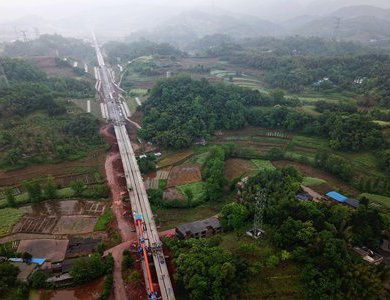
The construction of the Sichuan-Tibet railway, dubbed the world's most challenging railway, will have a big influence in boosting Tibet's integration into South Asia and the China-proposed Belt and Road initiative (BRI), as well as facilitating its trade connectivity with China's developed regions, industry observers said on Thursday.
The comments came after Chinese President Xi Jinping called for the full launch of the planning and construction of the 1,700-kilometer Sichuan-Tibet railway at a meeting held on Wednesday, the Xinhua News Agency reported.
The meeting emphasized that the railway, which will run from Chengdu, capital of Southwest China's Sichuan Province, to Lhasa, capital of Southwest China's Tibet Autonomous Region, will promote ethnic solidarity, safeguard national unity and consolidate the stability of the frontier, as well as bolstering Tibet's economic and social development, the report said.
The 250-billion-yuan ($36.16 billon) railway, which will have a designated speed of between 160 and 200 kilometers per hour, is expected to be completed by 2026, media reports said.
The line will go through the southeast of the Qinghai-Tibet Plateau, one of the world's most geologically active areas, which also has sharp changes in terrain. This means the construction of the railway line will have to overcome substantial risks.
Long Xingchun, an associate professor at China West Normal University, told the Global Times on Thursday that the railway could fuel Tibet's economic growth because it will connect Tibet with Sichuan, whose transportation network is also linked with other southwestern regions as well as more developed central and eastern regions such as the Yangtze River Economic Zone and the Guangdong-Hong Kong-Macao Greater Bay Area.
Upon completion, the travel time by train from Chengdu to Lhasa will reportedly be cut from 48 hours to about 13 hours.
"The shortened travel time will enable faster movement of goods and people between Tibet and wealthy regions of China, injecting new vigor into Tibet's economy," said Sun Zhang, a rail expert and professor at Shanghai Tongji University.
The project will also provide the second rail line into Tibet after the Qinghai-Tibet Railway. But Long noted that the new railway will offer more significant benefits than the first rail line.
Unlike Northwest China's Qinghai Province, which is relatively undeveloped, Sichuan is Tibet's most affluent neighbor, and is the center of China's southwest regions with a dynamic and vibrant economic structure. "So its economic radiation effect to Tibet will be much stronger," Sun told the Global Times.
It is also necessary to construct the railway so that goods can move quickly along the route without being affected by weather conditions, Long said.
"Every year, the Sichuan-Tibet highway is closed for up to six months due to natural disasters, blocking Tibet's trade connectivity with inland China," Long added.
In the long term, the railway could also potentially boost Tibet's tourism revenue as well as driving investment in its real economy, which will help bridge the gap between the country's western regions and those in the east, Sun noted.
Opening up more
Experts also pointed out that the railway can help Tibet play the role of an "intermediary" between Southwest China and South Asian countries such as Nepal and India. "The region could then utilize resources from home and abroad to drive its economy," Long said.
At the same time, more Chinese tourists will be eager to travel by train to South Asia and goods from northern India and Nepal can be shipped to China more quickly, helping the two nations to tap the Chinese market.
The prospect of connecting with South Asia is promising, as the railway line from Lhasa to Tibet's Xigaze, as part of an extension of the Qinghai-Tibet railway, was put into use in 2014. Meanwhile, the China-Nepal railway, which will link Nepal's capital Kathmandu with Xigaze, is expected to be completed by 2022.
Sun noted the integration into Sichuan's transportation network will open up more opportunities for Tibet to participate in and benefit from the BRI.
Chengdu operates multiple China-Europe freight trains, making it possible for Tibet to transport goods to Europe via the route. The region could also send goods to ports in South China's Guangdong Province, taking advantage of the Maritime Silk Road.
Courtesy: The Global Times
- India Supported Construction Of Four Schools In Nuwakot
- Mar 19, 2021
- Nepal Denies Permission For Third Phase Trial Of Vaccine Against COVID-19
- Aug 31, 2020
- Messi Can Only Cancel Barcelona Contract If €700 Million Release Clause Is Paid, La Liga Confirms
- Aug 31, 2020
- India To Carry Out Study On Kathmandu-Raksaul Railway
- Aug 28, 2020
- COVID-19: 1,351 Personal Of Nepal Police Infected
- Aug 28, 2020
















